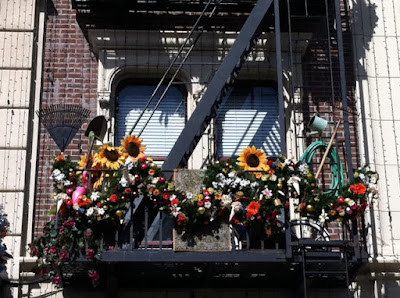Cities like New York and Chicago dress open urns and sidewalk esplanades in winter greens, branches and a variety of natural materials. Dried hydrangea, sedum, dogwood, ivy, nut buds, birds nests, pinecones, pine needles, or anything else interesting can duplicate the look at home. The dressed up container adds warmth and sophistication, with little effort and no cost.
Bill and I arrived late one night in Chicago on our way to a family wedding. City workers systematically dislodged summer annuals from the borders along Michigan Avenue and replaced them with full blooms. By morning it was as if the mums had sprouted overnight. The effect was more than aesthetic. Likened to a pair of newly polished shoes, the winter arrangements show warmth and attention to detail.
The same result can be achieved at the porch level--where the day begins and ends. Evergreen and boxwood branches, twigs, flowering shrub branches and any plant whose stems don't deteriorate in the cold are candidates. Leave out the pots, or fill other garden adornments such as wall planters or windowboxes.
Time to repurpose the Christmas tree, bough or wreath. For those who don't celebrate, or stick with artificial, there's plenty of candidates at the curb. Good thing it gets dark early.
Using a base of soil, possibly left from the previous annual occupant, it's critical to create these pots before the ground freezes solid. Start at the center with taller pieces of greenery. Don't skimp, the pot needs to be quite full. Then plant the branches, dried flowerheads, or anything else interesting. Wreaths can be dissasembled and used, or simply frame the pot, anchoring the inserted branches. Boughs can be disassembled or draped along a windowbox. The branches of a discarded tree will fill pots to overflowing.
For holidays, small adornments may be included. If ambitious, add elegant prelit twigs.
Best part's no maintenance, no cutting back and zero plucking of spent blooms. Snow simply adds to the interest.
Beats lugging them into the shed.
Planting Windowboxes -- No pane no gain
Container Gardens -- Pots on the Spot
Gnomes Get Kids Gardening
























